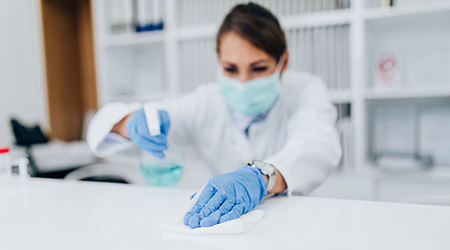Cleaning is removing. We do not hide or brush aside dust and waste and say we are cleaning. We must remove and dispose of them, too.
The U.S. Center for Disease Control and Prevention’s definition for cleaning refers to the removal of dirt and impurities, including germs, from surfaces. Cleaning alone does not kill germs. But removing the germs decreases their number and, therefore, the risk of spreading infection.
Washing or scrubbing a surface physically removes soil and organic material, such as blood and body fluids, and takes with it many germs.
For too long, clean has been a subjective term determined by a simple visual assessment. Two people inspecting the same room or the same object might have a different opinion about whether it passes the test.
The fact is surfaces that appear to be clean might not necessarily be clean when scientifically quantified or qualified. Remember, what you can’t see can hurt you. You should be striving for health-based or hygienic cleaning (cleaning for healthier environments and not just for appearances).
Hospital studies find only 25-45 percent of touchpoints nearest the patient met the definition of clean according to research criteria. Interventions raised the rate of clean to 75 percent. Improving cleaning processes and integrating measurement of touchpoints reduced risk of cross-contamination by 50-75 percent.
A well-trained staff given adequate time andequipped with the best tools, products, and processes will likely deliver a clean, sanitized, or disinfected room. But to be certain, you need to be able to demonstrate through measurement that the cleaning regimen is producing the desired results. Be intentional about measuring the important factors, especially the cleaning of touchpoints.
More people are augmenting or enhancing the visual inspection approach with rapid testing technologies and interventions, including educating, training, and better equipping the cleaning staff. If you start testing for cleanliness and sharing that information with your staff, you move them from saying, “I believe it is clean” to “I have taken measurements that help prove that it is clean.”
Integrated cleaning and measurement (ICM) is an approach to cleaning that incorporates measurement as one of the keys to process improvement. Cleaning professionals want to be able to organize and equip staff to focus on results and then prove that what they are doing is effective.
At its core, ICM is a four-step model: measure, compare, experiment, and implement. ICM is an open-source system and isn’t restricted by a single method or product. Rather, the system accepts all best-practice equipment and approaches, provided these are accompanied by measurement data confirming their effectiveness.
Those interested in evidence-based, objective measurement of surface hygiene are using various methods. Some are using dry or wet chemical markers that are invisible to the naked eye but show up with ultraviolet (UV) light. These markers are easily removed with normal cleaning. The transparent marker soils are placed on touchpoints before the cleaning is performed and then after cleaning, checked with a UV light to validate that they have been removed, along with any contaminants.
Others seeking evidence are using handheld meters that test surfaces for adenosine triphosphate (ATP), which is the energy molecule inside all living cells. ATP is found in bacteria, mold, fungus, and other organic matter that can provide a rich food source for pathogens.
ATP measurement has been used in food processing for years, but until now, the cleaning industry lacked precise, portable, and cost-effective devices. By providing feedback in less than 30 seconds, ATP meters enable cleaning professionals to verify how clean surfaces are with respect to organic matter and to carry out continuous improvement programs to enhance overall performance.
Other measures of clean include devices and measurement platforms that detect fungal enzymes, particles, airborne dust masses, moisture and more. These systems are becoming increasingly available, portable, and affordable.
Simple cleaning of environmental surfaces may be one of our key defenses in the future battle against infectious disease. With antibiotic-resistant organisms proliferating on common touchpoints for up to 56 or more days, the study of cleaning and measuring cleanliness is becoming all-important.
J. Darrel Hicks, BA, MESRE, CHESP, Certificate of Mastery in Infection Prevention, is the past president of the Healthcare Surfaces Institute. Hicks is nationally recognized as a subject matter expert in infection prevention and control as it relates to cleaning. He is the owner/principal of Safe, Clean and Disinfected. His enterprise specializes in B2B consulting, webinar presentations, seminars and facility consulting services related to cleaning and disinfection. He can be reached at darrel@darrelhicks.com or you can learn more at www.darrelhicks.com.

 Rethinking Strategies for Construction Success
Rethinking Strategies for Construction Success From Touchless to Total Performance: Healthcare Restroom Design Redefined
From Touchless to Total Performance: Healthcare Restroom Design Redefined New York State Approves $53M Construction Program at Niagara Falls Memorial Medical Center
New York State Approves $53M Construction Program at Niagara Falls Memorial Medical Center How Health Systems Are Rethinking Facilities Amid Margin Pressure
How Health Systems Are Rethinking Facilities Amid Margin Pressure Ground Broken on New Medical Office Building in Scottsdale, AZ
Ground Broken on New Medical Office Building in Scottsdale, AZ